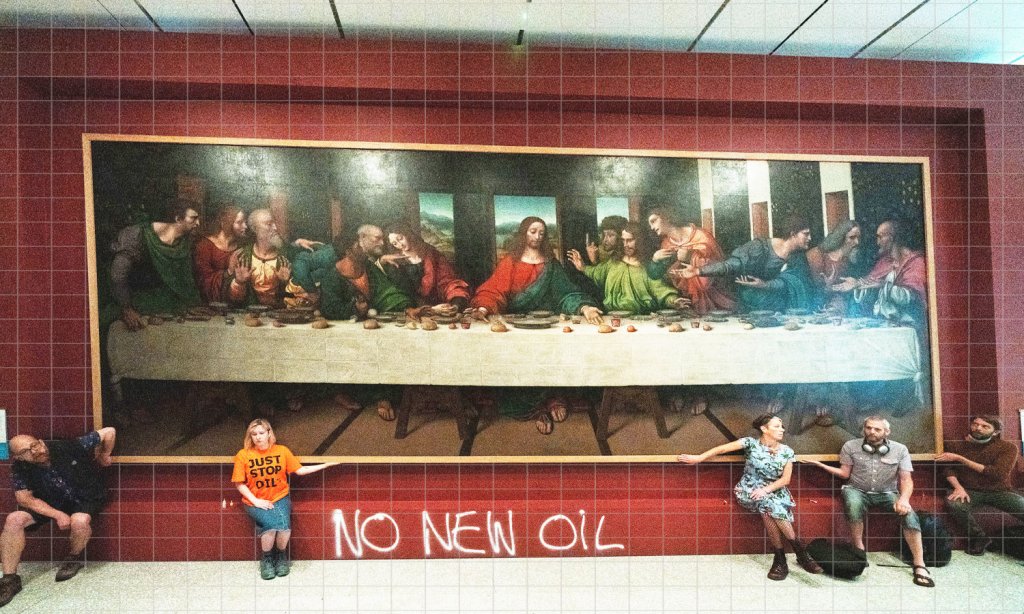Another artwork has been attacked. This time, the weapon used was mashed potato.
Just nine days after Vincent van Gogh’s Sunflowers were doused with a can of tomato soup at the National Gallery in London, protestors in Potsdam, Germany, have covered Claude Monet’s Les Meules in potato. Both groups then super-glued their hands to the wall.
“People are starving, people are freezing, people are dying. We are in a climate catastrophe and all you are afraid of is tomato soup or mashed potatoes on a painting,” the protestors in the Museum Barberini shouted.
“This painting isn’t going to be worth anything if we have to fight over food. When will you finally start to listen and stop business as usual?”
Attacking high-profile artworks to make points about the environment is the latest trend in climate protest, although there are serious questions raised about whether it furthers the cause or turns the public off.
In recent months, works by artists including Sandro Botticelli, Pablo Picasso, and Leonardo de Vinci have all been attacked, with Extinction Rebellion protestors gluing themselves to Picasso’s Massacre in Korea at the National Gallery of Victoria at the start of the month.
Sociologist and activism expert Dr Justine Lloyd says the trend has come about because of increasingly punitive measures placed upon the right to protest across the globe. Activists are now seeking out attention-grabbing ways of getting their message through without facing years behind bars.
“Extinction Rebellion and groups like Blockade Australia have been increasingly prevented from traditional forms of protests like street protests and the blocking of the traffic,” Lloyd told The Sydney Morning Herald.
Just Stop Oil, the group behind the soup attack, has recently ramped up its actions, saying that nothing short of the death penalty will prevent them from calling attention to the climate breakdown. They recently spray-painted the front of the department store Harrods, covering the building in orange paint, as well as a luxury car dealership days later.
Whether or not you agree with the tactics is beside the point; art galleries are having to step up their security to new heights to protect paintings.
In July, after protestors glued themselves to paintings at London’s Royal Academy, the Courtauld Gallery, and the National Gallery, the UK’s Museums Association told its members to tighten security.
Quoting from the National Police Coordination Centre, the organisation said, “The NPCC has advised UK police and constabularies to brief art galleries with high-value art collections in their area ‘to enable enhancement of their security as necessary'”.
Steve Keller, a museum security consultant of 35 years, told The Atlantic, that galleries around the world are “caring more about security, and the security tools that they have available to them are getting better constantly”.
“A museum might have to add $100,000 worth of additional security now for the next 20 years because it had this incident,” he said.
Keller also explained that, unlike the Monet that was covered in soup, not all paintings can be shielded by glass. Adding glass to a frame is costly and will damage the frame which galleries are reluctant to do if it’s a special or historical frame.
He also added that it’s virtually impossible to stop someone from throwing food at a painting without having all rooms staffed by guards with lighting-fast reaction speeds at all times.
The Latch reached out to a number of galleries in Australia to see what they’re doing about the heightened security risk. So far, just The Art Gallery of NSW has responded, offering the succinct statement that:
“The Art Gallery of New South Wales takes very seriously its responsibility to manage and safeguard the collection while ensuring its accessibility for visitors.”
It’s difficult to see how such an institution can function if paintings are constantly under threat. By their very nature, they offer art worth potentially millions of dollars up for viewing to the general public. Closing them all off, or heavily guarding each piece, would certainly affect the experience of visitors.
Security risk expert Andy Davis of international security firm ASIS has said that galleries must take a “proportionate approach to tackling the issue that minimizes the opportunity for protests while ensuring the protection of artifacts”.
He suggests that there is not one blanket solution to the problem, given that each institution will have its own risk tolerance and ability to mitigate, but he recommends galleries start performing bag searches upon entry, have rapid lockdown procedures, and consider prosecution of protesters as a deterrent.
Presumably, galleries around the world will be weighing up their options based on the current climate. With budgets in these spaces notoriously short, it’s difficult to see how many of them, particularly the smaller ones, will be able to cover the costs of such measures.
Despite the public backlash Just Stop Oil received after their soup protest, other direct-action climate groups seem to be replicating their efforts around the world. Either serious climate action is going to have to be taken, all art galleries are going to have to turn into Fort Knox, or paintings will continue to be mildly damaged in this global struggle.
Related: Why Protesting Matters: How Sydney’s Gay and Lesbian Mardi Gras Started As a Protest
Related: Are NFTs the Future? Results From Artist Damien Hirst’s Experiment Are in
Read more stories from The Latch and subscribe to our email newsletter.







